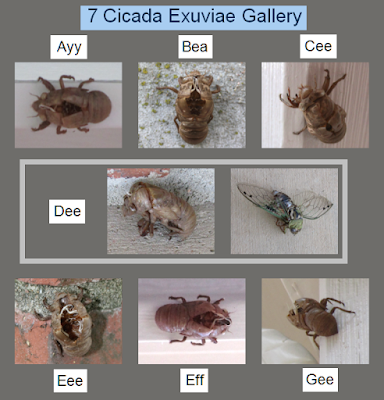The First Trio
The first cicada exuviae (exoskeleton) trio was at a rain shutoff device, spotted Sunday 8/18 elevenish. I might not have considered it unusual for one exuviae. Three, however, made me chuckle because they were so close to each other. I thought about threesomes—Three Stooges, Three Amigos, Three Musketeers, Kingston Trio, ….
The Rest of the Exuviae Hangups
Coincidentally, only a few minutes later at another part of the yard, another exuviae caught our eyes. While trimming some branches, the other co-trimmer thought one limb end had a particularly ugly cut. Looking closer, it turns out an exuviae was hugging it. This one might have been hanging out for awhile; closer look shows dust and tree debris. (In contrast, the trio looked pretty "clean" and shiny.)
In July 2017, a cicada molted and abandoned its shell at the front door step. The following other oddball spots were from July 2018:
- On a sidewalk curb
- On a car tire that faced the street (two different shells on two consecutive days)
- On a sago plant (another trio)
The other day, I saw that only one exuviae still hung out at the rain shutoff device—clinging to the wire. The other two shells apparently fell off. The remaining shell looks like a good example of a nymph having found a great item to clutch in preparation for self-extraction. It successfully implemented strategy that "Photo Essay: Cicada Nymph Molts into Adult" describes:
they find a place on a tree to grab hold and ‘affix’ themselves … Beginning around dusk the Cicada nymph crawls out of the ground and up a tree to affix itself to a sturdy part. This nymph circled this branch, feeling for a strong hold. Molting is quite a process and they’ll be there awhile, so they want to make sure not to fall during the process.Nevertheless, I used a twig for positioning the two other exoskeletons and taking additional pix for the video.
For more articles about cicadas, enter "cicada" in the search box at the upper left of this window. Or find and click "cicada" link at Partial Index of Keywords section (just below Popular Posts section).


